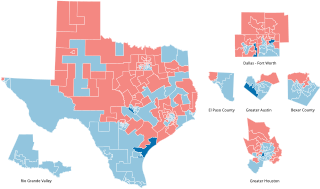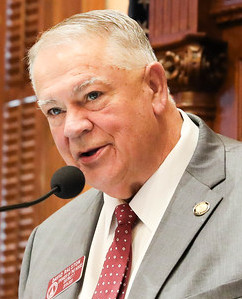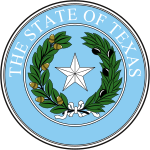
The 2006 Texas Legislature election was held on Tuesday, November 7, 2006, in the U.S. state of Texas. The Texas Legislature election was conducted as a part of the 2006 Texas general election, which also included the 2006 United States Senate election in Texas, the 2006 United States House of Representatives elections in Texas, and the 2006 Texas gubernatorial election.

The 2018 United States elections were held on Tuesday, November 6, 2018. These midterm elections occurred during Republican Donald Trump's term. Democrats made a net gain of 41 seats in the United States House of Representatives, gaining a majority in the chamber and thereby ending the federal trifecta that the Republican Party had established in the 2016 elections. The Republican Party retained control of the United States Senate, making a net gain of two seats and defeating four Democratic incumbents in states that had voted for Trump in 2016. As a result of the 2018 elections, the 116th United States Congress became the first Congress since the 99th United States Congress in which the Democrats controlled the U.S. House of Representatives and the Republicans controlled the U.S. Senate.

The 2020 United States Senate elections were held on November 3, 2020, with the 33 class 2 seats of the Senate contested in regular elections. Of these, 21 were held by Republicans, and 12 by Democrats. The winners were elected to six-year terms from January 3, 2021, to January 3, 2027. Two special elections for seats held by Republicans were also held in conjunction with the general elections: one in Arizona, to fill the vacancy created by John McCain's death in 2018; and one in Georgia, following Johnny Isakson's resignation in 2019. These elections ran concurrently with the 2020 United States presidential election in which incumbent Republican president Donald Trump lost to Democratic nominee Joe Biden.

The 2018 Georgia State Senate elections took place as part of the biennial United States elections. Georgia voters elected state senators in all 56 of the state senate's districts. State senators serve two-year terms in the Georgia State Senate.

The 2018 Texas House of Representatives elections took place as part of the biennial United States elections. Texas voters elected state representatives in all 150 of the state house's districts. State representatives serve two-year terms in the Texas State House. A statewide map of Texas' state House districts can be obtained from the Texas Legislative Council here, and individual district maps can be obtained from the U.S. Census here.

The 2018 Hawaii Senate elections took place as part of the biennial United States elections. Hawaii voters elected state senators in 13 of the state senate's 25 districts. State senators serve four-year terms in the Hawaii Senate.

The 2018 Maine State Senate elections took place as part of the biennial United States elections. Maine voters elected state senators in all 35 of the state senate's districts. State senators serve two-year terms in the State Senate.

The 2018 Georgia House of Representatives elections took place as part of the biennial United States elections. Georgia voters elected state representatives in all 180 of the state house's districts. State representatives serve two-year terms in the Georgia House of Representatives.

The 2018 Alabama Senate elections took place on November 3, 2018, as part of the 2018 United States elections. Alabama voters elected state senators in all 35 of the state's Senate districts. State senators serve four-year terms in the Alabama Senate.

The 2018 Iowa State Senate elections took place as part of the biennial 2018 United States elections. Iowa voters elected state senators in half of the state senate's districts—the 25 odd-numbered state senate districts. State senators serve four-year terms in the Iowa State Senate, with half of the seats up for election each cycle.

The 2010 Iowa State Senate elections took place as part of the biennial 2010 United States elections. Iowa voters elected state senators in half of the state senate's districts—the 25 odd-numbered state senate districts. State senators serve four-year terms in the Iowa State Senate, with half of the seats up for election each cycle.

The 2012 Iowa State Senate elections took place as part of the biennial 2012 United States elections. Iowa voters elected state senators in 26 of the state senate's 50 districts—the 25 even-numbered state senate districts and the 49th district. State senators serve four-year terms in the Iowa State Senate, with half of the seats up for election each cycle. This was the first election cycle following the 2010 census and 2011 redistricting process.

The 2004 Iowa State Senate elections took place as part of the biennial 2004 United States elections. Iowa voters elected state senators in half of the state senate's districts—the 25 even-numbered state senate districts. State senators serve four-year terms in the Iowa State Senate, with half of the seats up for election each cycle.

The 2020 Texas State Senate elections took place as part of the biennial United States elections. Texas voters elected state senators in 16 of the 31 state senate districts. State senators serve four-year terms in the Texas State Senate. Those elected in 2020 will only be elected for two years, however, as part of the 2-4-4 term system. A statewide map of Texas's state Senate districts can be obtained from the Texas Legislative Council. and individual district maps can be obtained from the U.S. Census.

The 2016 Texas State Senate elections took place as part of the biennial United States elections. Texas voters elected state senators in 16 of the 31 state senate districts. State senators serve four-year terms in the Texas State Senate. A statewide map of Texas's state Senate districts can be obtained from the Texas Legislative Council here, and individual district maps can be obtained from the U.S. Census here.

The 2014 Texas State Senate elections took place as part of the biennial United States elections. Texas voters elected state senators in 15 of the 31 state senate districts. State senators serve four-year terms in the Texas State Senate. A statewide map of Texas's state Senate districts can be obtained from the Texas Legislative Council here, and individual district maps can be obtained from the U.S. Census here.

The 2012 Texas State Senate elections took place as part of the biennial United States elections. Texas voters elected state senators in all 31 State Senate districts. Typically, State senators serve four-year terms in the Texas State Senate; however, all Senate seats come up for election in the cycle after decennial redistricting. Due to this, senators elected in 2008 served only two-year terms, and half of the senators elected in this election served two-year terms, coming up for re-election again in 2014. A statewide map of Texas's state Senate districts can be obtained from the Texas Legislative Council here, and individual district maps can be obtained from the U.S. Census here.

The 2022 United States state legislative elections were held on November 8, 2022 for 88 state legislative chambers in 46 states. Across the fifty states, approximately 56 percent of all upper house seats and 92 percent of all lower house seats were up for election. These midterm elections coincided with other state and local elections, including gubernatorial elections in multiple states.

The 2010 Texas State Senate elections took place as part of the biennial United States elections. Texas voters elected state senators in 16 State Senate districts. State senators typically serve four-year terms in the Texas State Senate, but all Senators come up for election in the cycles following each decennial redistricting. As such, all of the seats up for this election were for two-year terms, with senators up for re-election in the following 2012 Texas State Senate elections.
The 2011 United States state legislative elections were held on November 8, 2011. Seven legislative chambers in four states held regularly-scheduled elections. These off-year elections coincided with other state and local elections, including gubernatorial elections in four states.





















